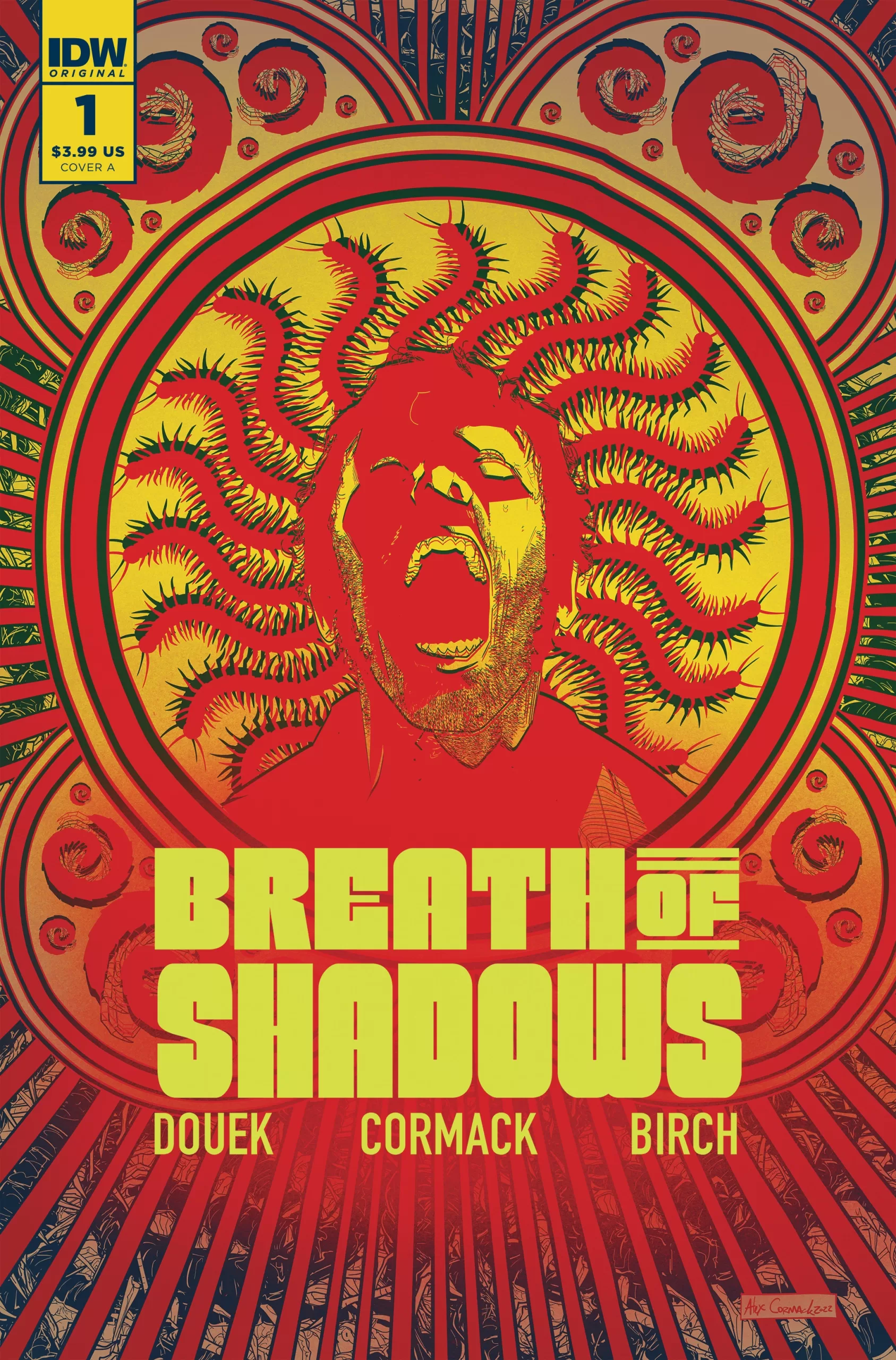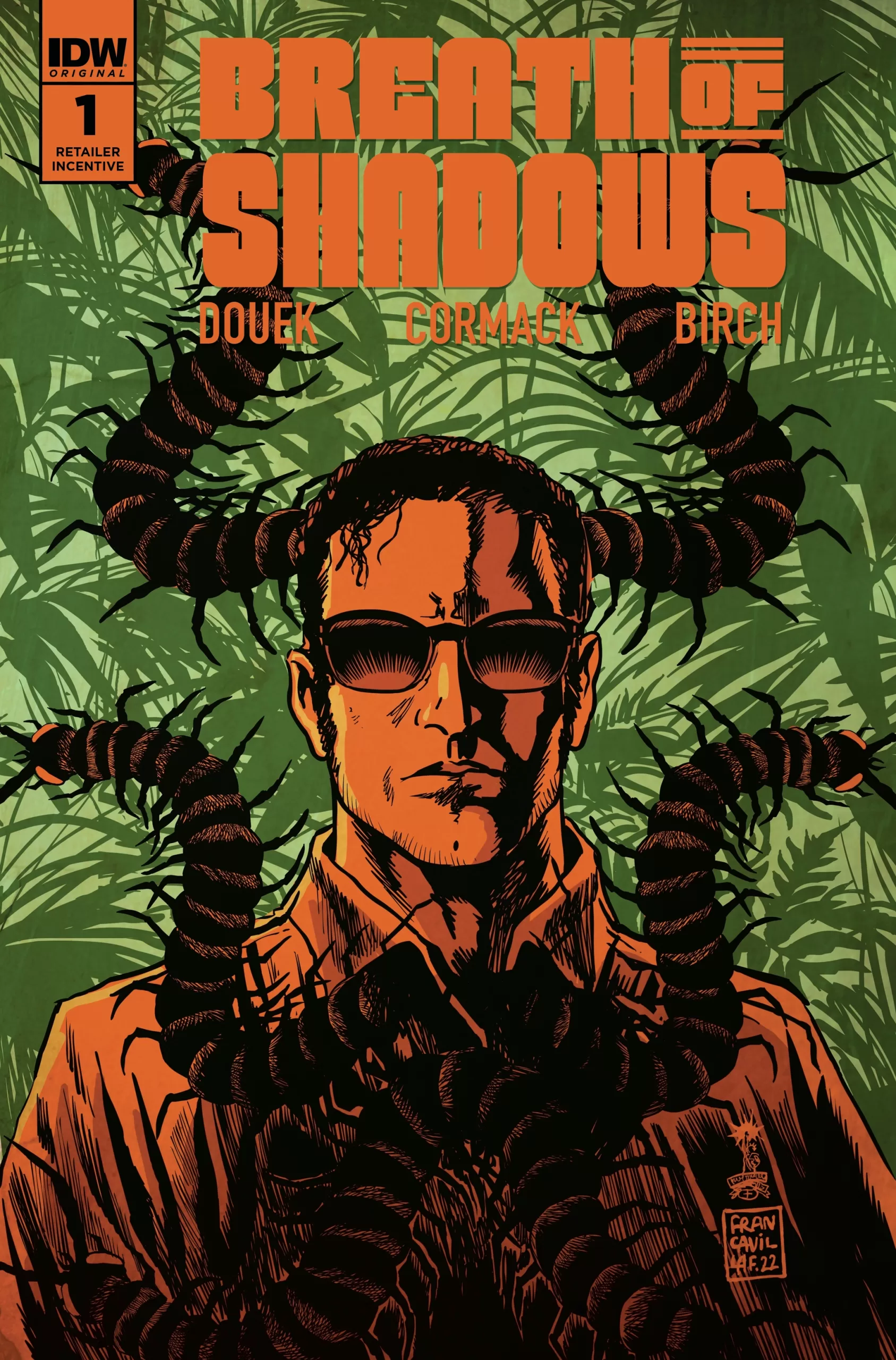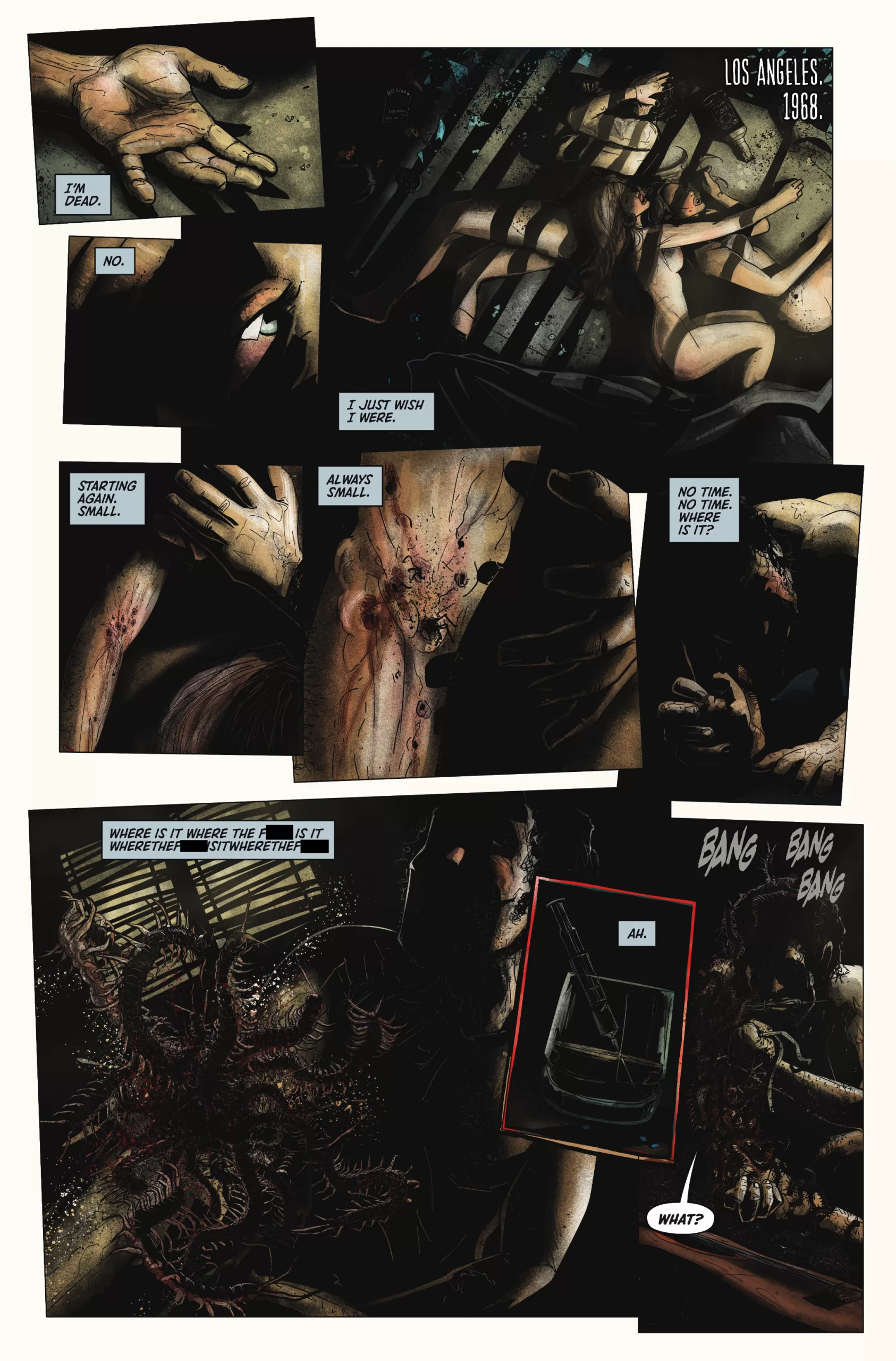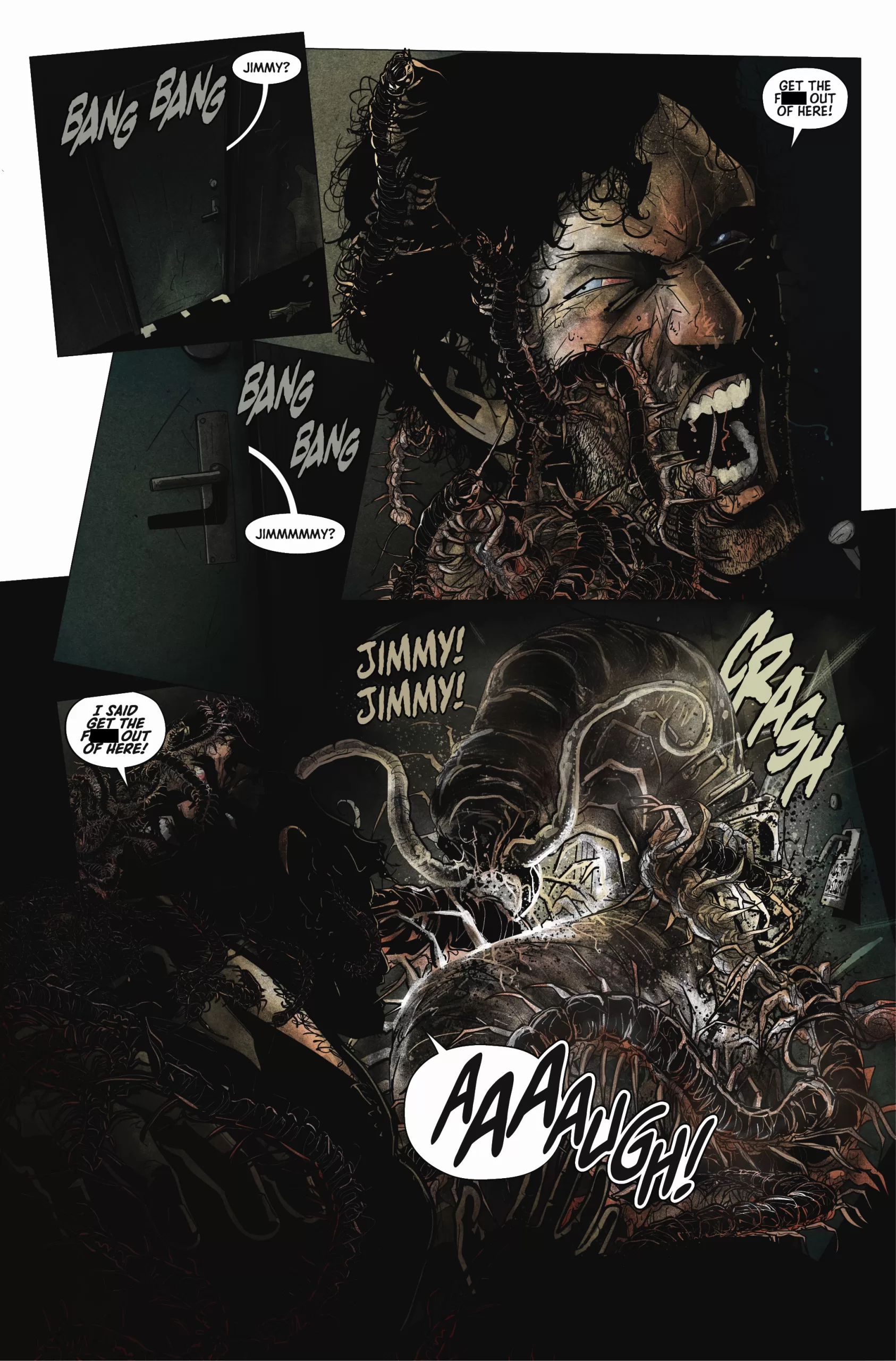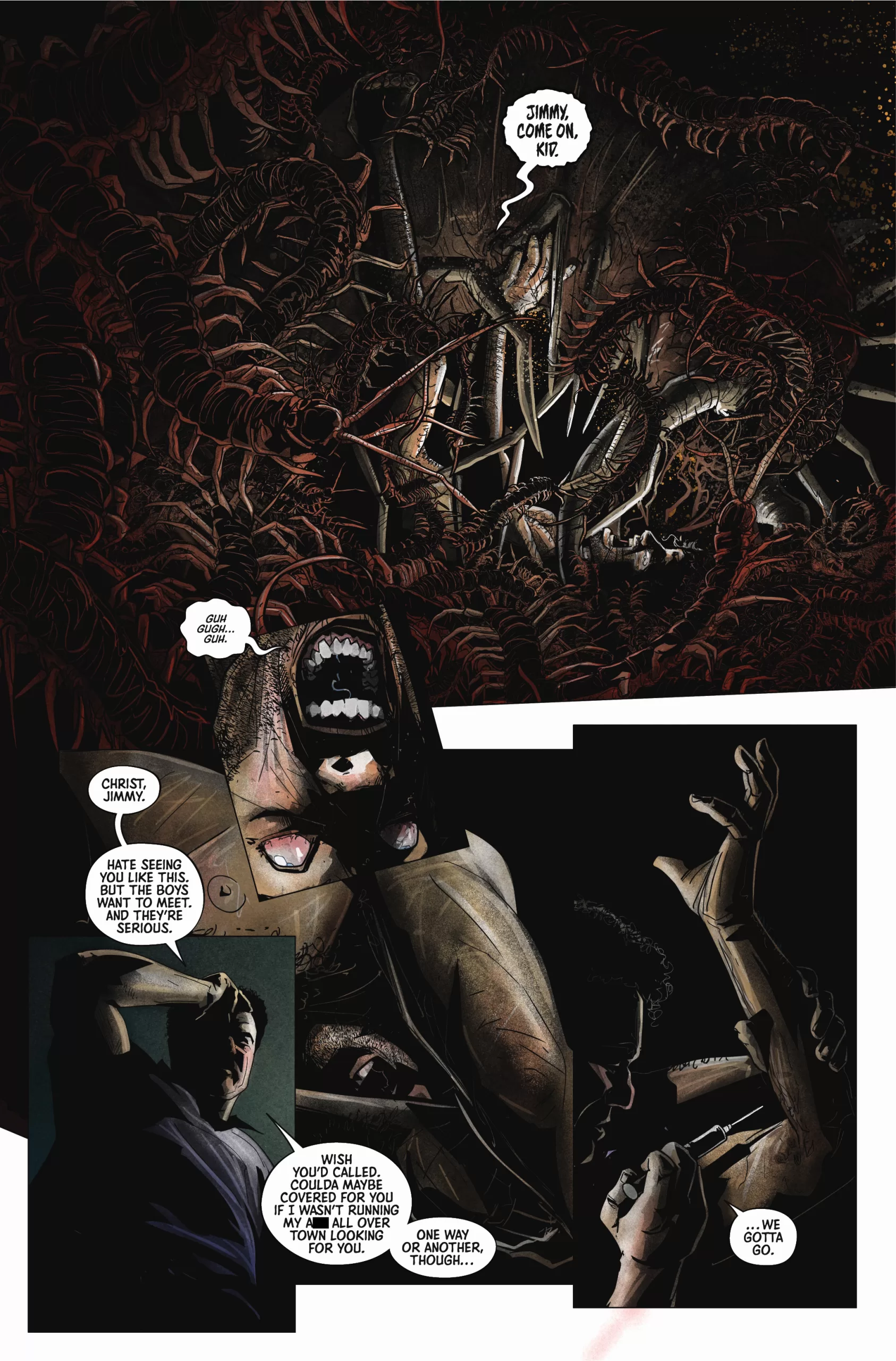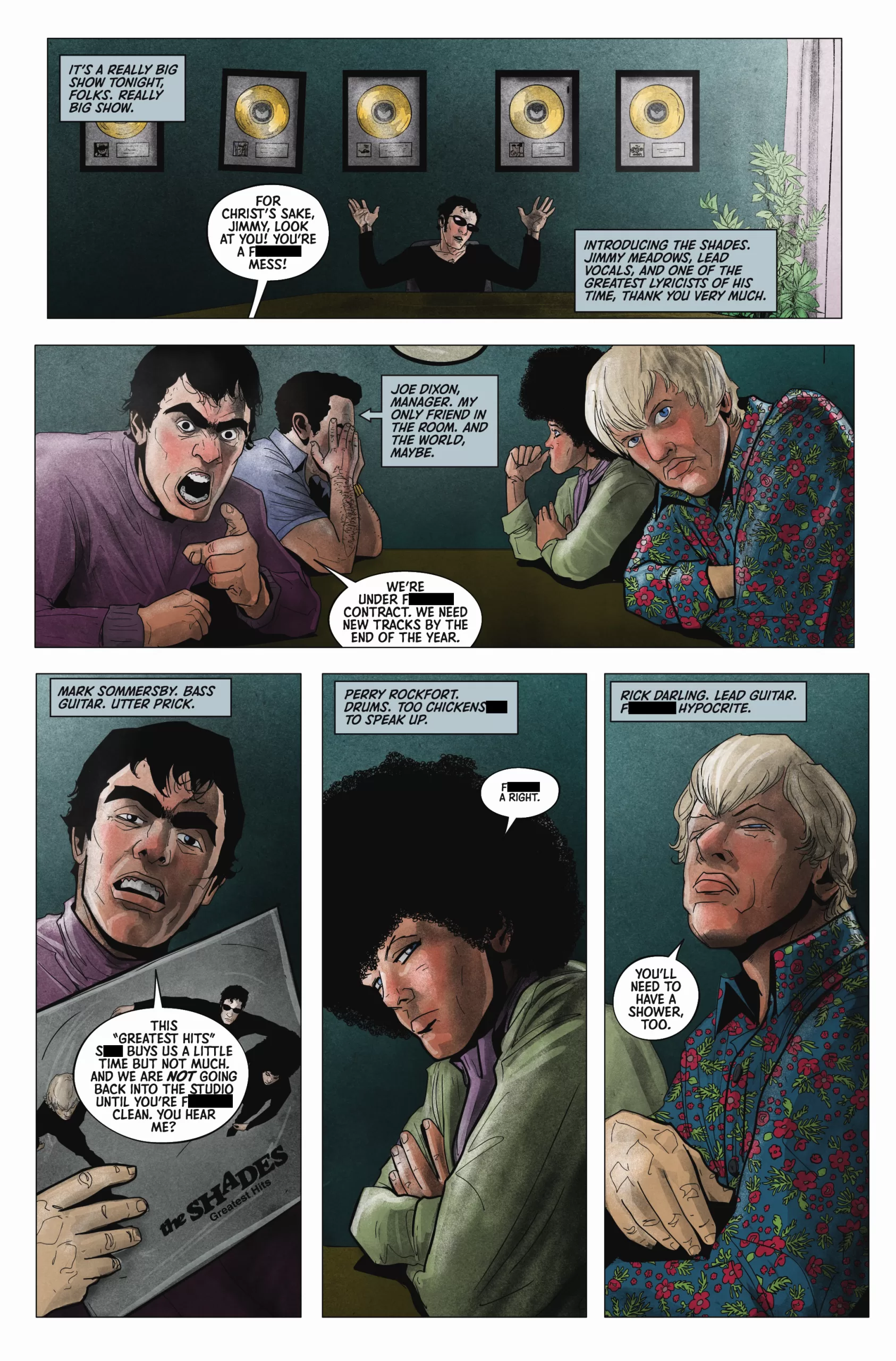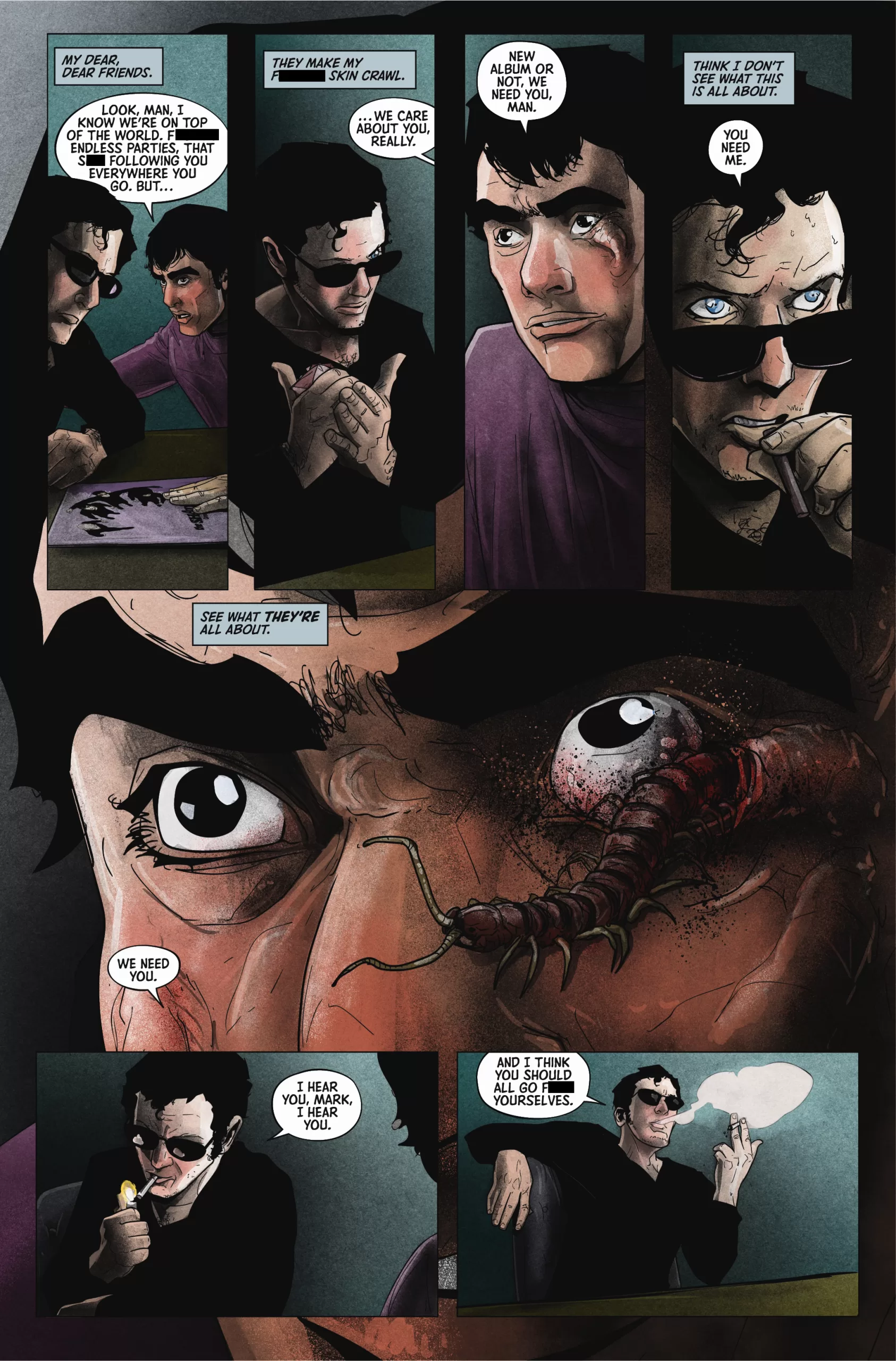In one of the trippiest first issues to introduce a new horror comic book series, Breath of Shadows is like witnessing a drug addict’s worst nightmare—freshly inked, and captured on a comic—one toke shy of over-the-line into hallucinogenic fury. It’s a story set during the peak of the psychedelic drug movement, smack dab in the transitional Rock-‘N’-Roll era of the 1960s.
Breath of Shadows follows the story of Rock Star Jimmy Meadows, a man whose rising artistic fame is surpassed in legend, only by his equally renown penchant for addictions, sex and drugs, specifically, heroin. The story takes readers on a strange journey of horrifying paranoia and head demons, where Jimmy must stumble forward along with his manager, team, and bandmates, across the jungles of South America.
Debuting tomorrow, February 1st, issue #1 will be the first of a five-issue limited run from Bram Stoker Award–Nominated Creators Rich Douek and Alex Cormack, whose recent horror runs for IDW have been nothing shy of spectacular.
We sat down to talk with co-creators Rich Douek and Alex Cormack about this upcoming new comic. We’ve also got some cover art and our detailed interview below.
INTERVIEW W/ RICH DOUEK
So this is your third book for IDW made with Alex Cormack. Can you share what this journey has been like together?
Rich: It’s been nothing short of amazing. Alex and I have been friends for a long time, but only started working together on Road of Bones. Going from that book to Sea of Sorrows, and now on to Breath of Shadows has made us both stronger creators, as we continue to build our respective skills, and inspire each other to reach new creative heights.
What makes Breath of Shadows unique from other series that you’ve worked on?
Rich: We’ve definitely explored the psychology of humans in desperate situations in our previous work, but Breath of Shadows takes things to a whole new level. We’ve got a large, diverse cast of characters, each bringing their own demons with them into the depths of the jungle, where all hell is going to break loose.
Ripping the band-aid right off… what made you want to write a body horror story about drugs and rock-and-roll? Was this based on any particular addiction experiences you knew of from the past?
Rich: I’ve always found rock and roll fascinating, especially the larger-than-life figures of the sixties, and the idea of writing a band with a lot of infighting just seemed like a lot of fun. As far as drugs go, yeah, I’ve had my experiences, and have been lucky enough to not wreck my life over them. I can’t say the same for everyone I know, and I’ve witnessed firsthand the impact they can have on someone’s life. A certain amount of the experiences in the book are drawn from real life, while others are drawn from my research on the subject, which included books like Junky and Naked Lunch. And once you really delve into the mechanisms and feelings of addiction, well, body horror seems like a natural fit.
I love Jimmy Meadows, the lead vocalist of The Shades. There’s an acerbic wittiness to him and that line asking if he could smoke that flower from a hippie? Totally, hilarious. Was there anyone(s) in particular that Jimmy Meadows was based on?
Rich: Ha! I appreciate that, because I like Jimmy a lot too, even though I am the first to admit, I did not write him to be especially likeable—in fact, I could very easily see a lot of readers finding him infuriating! But I wanted him to have that kind of rock star magnetism, that feeling where someone can be living their lives as an absolute train wreck, but still somehow be the coolest person in every room they walk into. In terms of real life figures, he’s a bit of a pastiche of some of the big rock stars of the era—there’s a bit of Jim Morrison in him, a bit of John Lennon, as well as a bit of less popular, but no less seminal figures like Lou Reed, and Harry Nilsson.
This story takes place during the transitional era of the 60s into the 70s. That ‘Fear and Loathing’ moment and the peak of the psychedelic movement. You mentioned in issue 1, The Beatles, but what other bands or types of music do you think influenced your take on the story?
Rich: I made a huge Spotify playlist to keep on while I researched and wrote – you can even check it out here if you want! I started with some of the staples, like The Rolling Stones, The Beatles, and The Doors, but also included bands like The Stooges, The Velvet Underground, and Jefferson Airplane. For me it was about capturing the vibe of the time, and the story—as you said, the height of the psychedelic movement, right before it soured into something infinitely more downbeat and cynical—what I was really looking for in selecting the songs was finding those moments where you can almost see the end coming, like Hunter S. Thompson said in Fear and Loathing; the high water mark—that place where the wave finally broke and rolled back.
Finally, for readers considering picking up this series, what would you like for them to take away from this comic after reading it?
Rich: Like with any book, I hope they have a great time reading it—but what I’d really love for people to take from it is a bit of awareness of how easily horror can creep into our lives—I’m not talking about monsters or bugs or things like that, but an almost existential force born out of the choices we make in life. When asked about the title Naked Lunch, William S. Burroughs said, it means exactly what the words say—a frozen moment when everyone sees what is on the end of every fork. My deepest ambition would be for people to experience something just like that—a moment where they might stop and wonder what they would do, who they might be, when they’re stuck in the shadows with something horrible breathing down their neck.
INTERVIEW W/ ALEX CORMACK
This is your third book for IDW made with Rich Douek. In your experience, what’s the journey been like for you together?
Alex: It is! It’s been great, ever since I got the call from Rich while standing in my in-laws’ kitchen saying that IDW digs ROAD OF BONES, they’ve been fantastic to work with.
You’ve done different environments in your comics together but Jungles were important to you in this one. Can you talk about the elements of the rainforest you incorporated into this?
Alex: I’ve always wanted to draw something in the jungle, since I was a kid watching INDIANA JONES, I don’t know if I could say specifically, But the tangle of vines and trees, all the palms, trying hard to make it look hot and uncomfortable, each background was a joy to draw!
Luckily my son loves the JUNGLE BOOK so we’ve had the animation and the live action movies on a bunch which has been very helpful!
Are there any Mayan or Mexican influences featured in your upcoming issues?
Alex: The Mayan ruins especially but specifically through the illustrations of Frederick Catherwood. Along with John Lloyd Stephens they found a number of ruins and sculptures in the 1830s and 40s. Catherwood illustrated ruins using a camera lucida and drew them as close to the real thing as he could. A lot of his illustrations I used as influence even though our spot is fictional.
I really like your linework as an artist. It’s very detailed and great for capturing moments of gruesome horror. Can you share with readers, what you do differently with your approach when doing spatter work or shading in a horror comic versus other sorts of comic art?
Alex: Thanks so much! It all depends on what’s going on in the story, heavy moments will have some heavy noir lighting, lighter moments will have the all the lights on. If it’s a lighter part of the story I may add a cartoony look to the illustration. A lot of shading and drawing techniques will change from story to story but whatever I do I have to make sure that it’s in service to the story.
Some of the visceral images are trippy and grotesque in this. The millipedes are kind of the perfect monster metaphor for an ex-heroin addict. Can you tell us what it’s like drawing the pindrop moment in a comic? How do you find creative ways to shock people while reading?
Alex: This reminds me of a time my wife caught me saying to myself hmmm this looks pretty gross, I think I’m done. Those scenes are the most fun to draw, I’ll map them out in layouts and then film myself acting out the scene and will draw from that. Each one of those scenes is different though, each has its own story behind them.
The nice thing about doing the colors with my wife Ashley is that I can get a second chance if I don’t think an illustration is working. I can go back and get it the best I can make it, this happened just recently in a crazy part in issue four (when you see it you’ll know what I’m talking about).
Finally, what’s something that you’re really proud of regarding how this visually came out?
Alex: I’m so proud of this book, I could draw it forever. The jungle scenes especially have been so much fun. The characters, their clothes, the background characters, the centipedes upon centipedes upon centipedes! There have been so many great challenges in this, I loved putting down every line.
And that was it! Thanks again to Rich Douek and Alex Cormack for this awesome interview along with the folks at IDW and Laura, most especially! Breath of Shadows releases tomorrow. You can see the first five pages of the interior art above to check it out.

